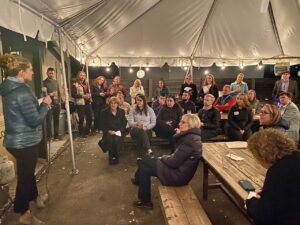By Miranda Ericksen
In 2016, current Denver District Attorney Beth McCann was inspired by then-state Rep. Pete Lee to tackle punitive sentencing and high rates of incarceration in a different way.
Lee was passionate about the idea of “restorative justice,” a response to crime that focuses on repairing the harm caused by a criminal offense, and McCann followed suit as an advocate for the movement in Denver.
The restorative justice approach allows victims to feel empowered, defendants to understand the effects of their crimes, and it affords both sides an opportunity to collaborate on a path to repair the harm done. According to McCann, the restorative justice program “provides a voice to the victim that they might not otherwise have.”

In 2019, McCann’s office collaborated with The Conflict Center, a Denver-based nonprofit founded on the belief that the criminal justice system should engage in practices that give offenders the opportunity to take accountability and repair harm.
The Conflict Center, off of 41st Avenue and Tejon Street in the Sunnyside neighborhood, has been teaching effective conflict management within the Denver community since 1987. They focus on three key areas of practical peacemaking in the home, effective conflict management in the community, and the implementation of restorative practices in schools.
The partnership, called Restorative Denver, uses the community-group conferencing model to bring together the victim or their surrogate, the defendant, and members of the community to repair the harm done without going down traditional punitive pathways.
When a case is referred to the program, the person who was harmed can choose the Restorative Denver pathway for the defendant or “the person who did the harm.” The victim meets with trained facilitators and volunteers representing the Denver community to compose a detailed list of conditions that the offender must agree to in order to keep the case from going back into the traditional system.
Participation in the program is entirely voluntary for both parties, and either side can choose to end their participation at any time up until the contract is signed. Once the contract is signed, the defendant’s case is removed from the traditional system and held until Restorative Denver reports a positive outcome to the DA.
It’s hardly a “get out of jail free” card, as the Restorative Denver team members hold defendants fully accountable for their compliance with the agreed upon contract. The second chance is considered a privilege and if the defendant does not comply, their case is turned back over to the DA’s office and put through the traditional punitive system.
Once completed, The Conflict Center refers the case back to the DA’s office and the charges are dismissed and the case is sealed, according to the center’s website. This gives the defendant incentive to repair the harm they caused to the community while also providing them skills to contribute positively to their communities once they complete the program.
The program has kept more than 70 cases out of the traditional justice system throughout the past three years, increasing from an average of one case per month in 2019 to over 10 cases per month in 2022, according to the DA’s office. The average recidivism rate of the program has been about 2%, which the DA’s office stated is 15% lower than the average recidivism rate of more traditional punitive methods. But these methods go beyond statistics.
Abby Ferber, a victim who participated in Restorative Denver, stated that she struggled to report her crime because she was not satisfied with the traditional option to drop charges or go to trial.
“Had I known (Restorative Denver) was available, I would have felt less tormented about reporting (the crime committed against me),” she stated.
Through the program, Ferber was able to directly express the harm’s impact and gained the closure she was seeking when initially struggling with how to pursue justice.

Be the first to comment